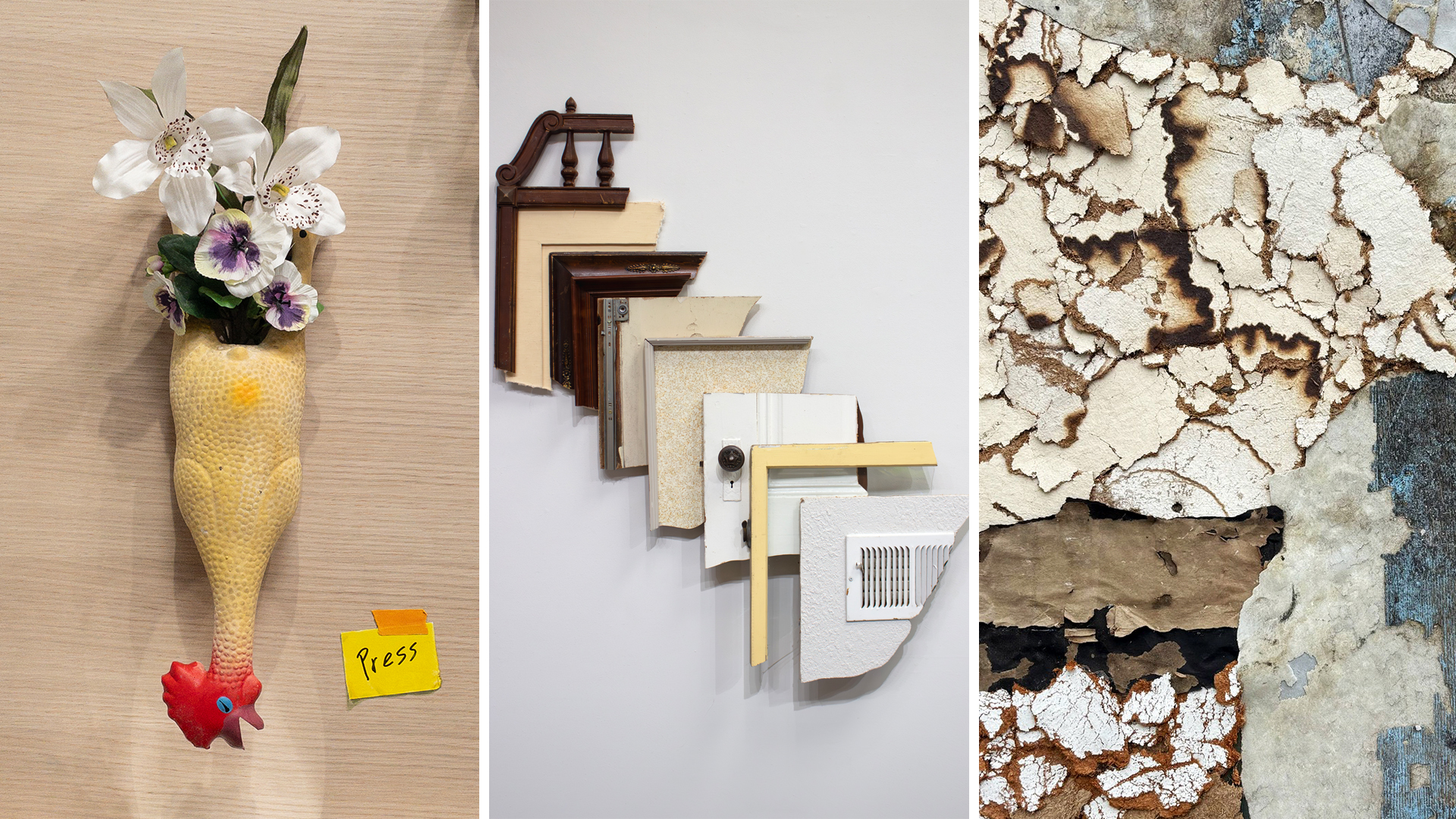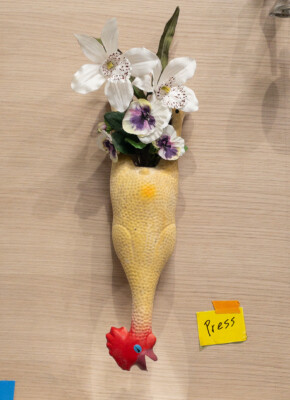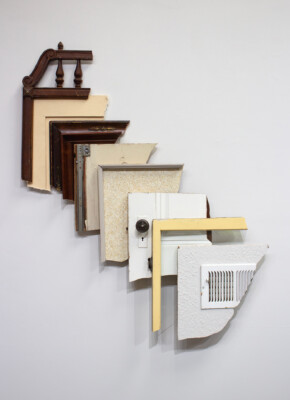
FOR IMMEDIATE RELEASE
Work by Michael Hall, Helia Pouyanfar, and University of California, Berkeley undergraduate Elizabeth Estrada.
The Artist in Residence Program at Recology San Francisco is thrilled to announce exhibition dates for current artists-in-residence Michael Hall, Helia Pouyanfar, and University of California, Berkeley undergraduate Elizabeth Estrada.
Friday, September 12, 2025 from 5 – 8 PM
Saturday, September 13, 2025 from 12 – 3 PM
Tuesday, September 16, 2025 from 5 – 7:30 PM with artist talk by Elizabeth Estrada at 6 PM(401 Tunnel), Michael Hall at 6:30 PM (503 Tunnel), and Helia Pouyanfar at 7 PM (503 Tunnel).
Admission is free and open to the public; no reservation required. All ages are welcome and the site is wheelchair accessible.
Location
Recology Art Studios
503 and 401 Tunnel Avenue, San Francisco
 Michael Hall
Michael Hall
Song Cycle
Written by Weston Teruya
Each work in Michael Hall’s Song Cycle rewards sustained observation. The assemblages of sculpture and painting have an improvised, responsive feel as elements play off of the wear and history evident on their substrates and other materials gathered from Recology’s Public Recycling and Reuse Area. The resulting details–holes that hold small trinkets, a sliver of mirror reflecting the incongruent textile pattern beneath an Atlas figurine, or the careful rendering of a painted landscape–might draw initial attention. But it is on the subsequent search for more of these details that other layers reveal themselves. Throughout the exhibition, Hall inserts subtle trompe-l’oeil painted flourishes: nail holes, blue tape, a jagged edge on a wood surface. What might appear to be a handwritten post-it note absent mindedly left on a blank wall turns out to be a carved wood replica. Additionally, mirrored surfaces throughout the installation fragment the visual plane, interrupting and augmenting the process of looking. We are continuously being asked to consider our viewership as much as what is being viewed. In a time when digital tools allow for the over proliferation of convincing fake images, there is an urgency to Hall’s call to look critically and parse illusions.
Befitting the titular evocation of music, Hall also punctuates pieces with sound elements that audiences are welcome to activate: a squeaking rubber chicken, a bell, metronome mechanisms. Like the visual textures that open up on close examination, the sonic elements require us to be present in the moment of observation–these are beats that are only revealed in the moment and require our attention.
In his broader practice, Hall often uses materials from his personal collection–family belongings and sentimental objects–and attends to them by rendering them in meticulous photorealistic detail. Here Hall turns that sense of consideration to objects that belonged to others. Even if the stories behind each item remain inscrutable, Hall makes evident the responsibility he feels to care for the materials–not by covering up and polishing their surfaces, but by embracing their unique histories.
Michael Hall is a Bay Area artist and educator whose drawings, paintings, and videos examine personal and mass-produced objects made unique through their idiosyncratic wear and tear. Hall focuses on how these common objects act as markers of time and place while also conjuring personal histories, collective desires and cultural phenomena. Hall is a recipient of both a Joan Mitchell Foundation Painters and Sculptors Grant and a MFA Fellowship at the Headlands Center for the Arts. His exhibitions include Townsend Center for the Humanities, Catharine Clark Gallery, San Francisco Arts Commission Gallery, Patricia Sweetow Gallery, and Southern Exposure. Hall received his BFA from the California College of the Arts and his MFA from Mills College. He has taught at Creative Growth Art Center, Mills College, UC Berkeley, and Pont Aven School of Contemporary Art. Hall is currently an Associate Professor of Painting and Drawing at California State University East Bay.
 Helia Pouyanfar
Helia Pouyanfar
Addendum
Written by Weston Teruya
Helia Pouyanfar’s Addendum uses fragments of everyday domestic architecture and discarded construction debris as sculptural meditations on the complexities of the refugee experience. Her works embrace the poetic tension in using residential building materials, as a physical home is one of the belongings that cannot be uprooted to carry across borders. Through the embrace of these found objects, her artistic process becomes a means of understanding dislocation and survival.
For refugees, the loss of home is irresolvable. Pouyanfar asks us to consider what might be generated in a new context and the process of becoming untethered from one’s homeland. Her work suggests something that isn’t necessarily liberatory, but what she describes as having a “perverse freedom” in its disorientation. The materials show wear and the wounds of demolition, but she brings them together with tenderness and craft. A truncated section of tree bursts from the perfectly sized gap in a section of wood floor planks. Sections of drywall are peeled and jagged, but carefully oriented. A neatly arranged spread of broken cabinetry, window frames, doors, and vents create a echoed refrain of corners.
To take in Pouyanfar’s pieces, we need to physically reorient how we view what might otherwise be easily overlooked building surfaces. Moulding we might normally see at the edge of the ceiling above us is now on the floor; interior infrastructures have been opened up to be peered at from beneath and behind. These subtle shifts in viewership ask for consideration of the human body in relation to these materials: our own, implied past occupants of these buildings, workers who handled them, and the embodied refugee experience. Pouyanfar reemphasizes this in her recurring use of handles and knobs that imply the touch of a hand and compartments that suggest an interiority, both physical and emotive. Intimate details–a photograph veiled behind a translucent fabric, items hidden in a drawer, a partially melted candle–suggest elusive stories that dart away before we can fully hold them. They gesture to narratives not for us to resolve, but a sustained tension of life and longing we are invited to connect with.
Helia Pouyanfar is an interdisciplinary artist whose work investigates the permanently transient state of the refugee body and its negotiation and reconciliation with place. Pouyanfar received her B.A. in Art Practice from the University of California, Berkeley and her MFA in Studio Art from the University of California, Davis. She has been the recipient of a Berkeley Civic Arts Individual Artist Grant, and a Kala Art Institute Fellowship. Her work has been exhibited at the Manetti Shrem Museum of Art, de Young Museum, Skirball Cultural Center, Miami University, Foyer-LA, Root Division, Southern Exposure, Berkeley Art Center, Richmond Art Center, and SF Camerawork.

Elizabeth Estrada
Entropy
Written by Weston Teruya
The installation of Elizabeth Estrada’s Entropy gives the impression of a set design for a dystopian performance that was just completed or is yet to be enacted. Her pieces, including large collages of found materials–woven lauan, patterned clumps of water damaged fibreboard, layered strips of bleached wood–and frames holding together shattered faux marble tiles, embrace the textures of material decay and weathering, suggesting slow societal and environmental dissolution.
While Estrada embraces this fragility, her interests are not in a fatalistic view of collapse, but decay as part of a cyclical state; a step before a return and new growth. There is a beauty in the discards. Her crafting of these pieces highlights the broken and tossed away to explore larger cultural mythologies. The passage of time evident in the material asks what knowledge might be gained and transmitted across generations, whether in trash, memes, or memorials. She weaves poetic fragments throughout the installation–erasure poetry written using news articles and other found text–that hint at broader social conditions, how we collectively contend with a culture of pain, and how our challenges have been inflicted outward beyond our borders. If, as Estrada suggests, this is a set for an unseen performance, we are being tasked to ask what led to this moment and what we want to come next.
Elizabeth Estrada is a multidisciplinary artist from Los Angeles who weaves together painting, poetry, sculpture, and performance. She has exhibited work and performed poetry and improv throughout California. She will receive her BA in Art Practice and Creative Writing at the University of California, Berkeley.